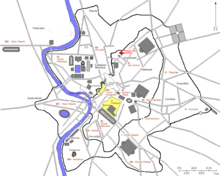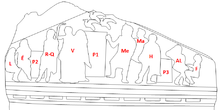Temple of Quirinus
The Temple of Quirinus (Latin : Aedes Quirinus or Templum Quirinus) was an ancient Roman temple built on the western half of the Quirinal Hill near the Capitolium Vetus, on a site which now equates to the junction between Via del Quirinale and Via delle Quattro Fontane, beside Piazza Barberini.[1][2] Domitian later built the Temple of the gens Flavia nearby.[3]

According to ancient authors, the temple of Quirinus was built and dedicated to Quirinus (the deified form of Romulus) by the consul Lucius Papirius Cursor in 293 BC.[4][5]
If still in use by the 4th-and 5th century, it would have been closed during the persecution of pagans in the late Roman Empire.
Fieldwork conducted by Andrea Carandini employed ground penetrating radar on the Quirinal Hill, revealing possible remains of the temple.[6]

See also
References
- Samuel Ball Platner (21 May 2015). A Topographical Dictionary of Ancient Rome. Cambridge University Press. pp. 438–. ISBN 978-1-108-08324-9.
- Filippo Coarelli (10 May 2014). Rome and Environs: An Archaeological Guide. Univ of California Press. pp. 233–. ISBN 978-0-520-28209-4.
- Andrew Zissos (7 March 2016). A Companion to the Flavian Age of Imperial Rome. John Wiley & Sons. pp. 120–. ISBN 978-1-4443-3600-9.
- Duncan Fishwick (October 1993). The Imperial cult in the Latin West 001. BRILL. pp. 58–. ISBN 90-04-07179-2.
- Penelope J. E. Davies (30 November 2017). Architecture and Politics in Republican Rome. Cambridge University Press. pp. 284–. ISBN 978-1-107-09431-4.
- Andrea Carandini (2007). Cercando Quirino: traversata sulle onde elettromagnetiche nel suolo del Quirinale. G. Einaudi. ISBN 978-88-06-19084-2.